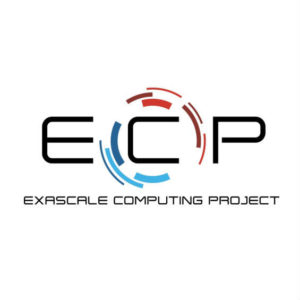 Today the Department of Energy’s Exascale Computing Project (ECP) announced its first round of funding with the selection of 15 application development proposals for full funding and seven proposals for seed funding, representing teams from 45 research and academic organizations.
Today the Department of Energy’s Exascale Computing Project (ECP) announced its first round of funding with the selection of 15 application development proposals for full funding and seven proposals for seed funding, representing teams from 45 research and academic organizations.
These application development awards are a major first step toward achieving mission critical application readiness on the path to exascale,” said ECP director Paul Messina. “A key element of the ECP’s mission is to deliver breakthrough HPC modeling and simulation solutions that confidently deliver insight and predict answers to the most critical U.S. problems and challenges in scientific discovery, energy assurance, economic competitiveness, and national security,” Messina said. “Application readiness is a strategic aspect of our project and foundational to the development of holistic, capable exascale computing environments.”
The awards, totaling $39.8 million, target advanced modeling and simulation solutions to specific challenges supporting key DOE missions in science, clean energy and national security, as well as collaborations such as the Precision Medicine Initiative with the National Institutes of Health’s National Cancer Institute.
Exascale refers to high-performance computing systems capable of at least a billion billion calculations per second, or a factor of 50 to 100 times faster than the nation’s most powerful supercomputers in use today.
The application efforts will help guide DOE’s development of a U.S. exascale ecosystem as part of President Obama’s National Strategic Computing Initiative (NSCI). DOE, the Department of Defense and the National Science Foundation have been designated as NSCI lead agencies, and ECP is the primary DOE contribution to the initiative.
The ECP’s multi-year mission is to maximize the benefits of high performance computing (HPC) for U.S. economic competitiveness, national security and scientific discovery. In addition to applications, the DOE project addresses hardware, software, platforms and workforce development needs critical to the effective development and deployment of future exascale systems.
First-round funding (see list at bottom) includes a broad set of modeling and simulation applications with a focus on portability, usability and scalability. A key consideration in the selection process was each team’s emphasis on co-design of the applications with the ECP’s ongoing development of hardware, software and computational capabilities, including physical models, algorithms, scalability and overall performance.
Projects will be funded in the following strategic areas: energy security, economic security, scientific discovery, climate and environmental science, and healthcare.
Leadership of the Exascale Computing Project comes from six DOE national laboratories: The Office of Science’s Oak Ridge, Argonne and Lawrence Berkeley national labs, and NNSA’s Lawrence Livermore, Los Alamos, and Sandia national labs.
The full list of application development awards follows:
Full Funding:
- Computing the Sky at Extreme Scales, Salman Habib (ANL) with LANL, LBNL
- Exascale Deep Learning and Simulation Enabled Precision Medicine for Cancer, Rick Stevens (ANL) with LANL, LLNL, ORNL, NIH/NCI
- Exascale Lattice Gauge Theory Opportunities and Requirements for Nuclear and High Energy Physics, Paul Mackenzie (FNAL) with BNL, TJNAF, Boston University, Columbia University, University of Utah, Indiana University, UIUC, Stony Brook, College of William & Mary
- Molecular Dynamics at the Exascale: Spanning the Accuracy, Length and Time Scales for Critical Problems in Materials Science, Arthur Voter (LANL) with SNL, University of Tennessee
- Exascale Modeling of Advanced Particle Accelerators, Jean-Luc Vay (LBNL) with LLNL, SLAC
- An Exascale Subsurface Simulator of Coupled Flow, Transport, Reactions and Mechanics, Carl Steefel (LBNL) with LLNL, NETL
- Exascale Predictive Wind Plant Flow Physics Modeling, Steve Hammond (NREL) with SNL, ORNL, University of Texas Austin
- QMCPACK: A Framework for Predictive and Systematically Improvable Quantum‐Mechanics Based Simulations of Materials, Paul Kent (ORNL) with ANL, LLNL, SNL, Stone Ridge Technology, Intel, Nvidia
- Coupled Monte Carlo Neutronics and Fluid Flow Simulation of Small Modular Reactors, Thomas Evans (ORNL, PI) with ANL, INL, MIT
- Transforming Additive Manufacturing through Exascale Simulation (TrAMEx), John Turner (ORNL) with LLNL, LANL, NIST
- NWChemEx: Tackling Chemical, Materials and Biomolecular Challenges in the Exascale Era, T. H. Dunning, Jr. (PNNL), with Ames, ANL, BNL, LBNL, ORNL, PNNL, Virginia Tech
- High-Fidelity Whole Device Modeling of Magnetically Confined Fusion Plasma, Amitava Bhattacharjee (PPPL) with ANL, ORNL, LLNL, Rutgers, UCLA, University of Colorado
- Data Analytics at the Exascale for Free Electron Lasers, Amedeo Perazzo (SLAC) with LANL, LBNL, Stanford
- Transforming Combustion Science and Technology with Exascale Simulations, Jackie Chen (SNL) with LBNL, NREL, ORNL, University of Connecticut
- Cloud-Resolving Climate Modeling of the Earth’s Water Cycle, Mark Taylor (SNL) with ANL, LANL, LLNL, ORNL, PNNL, UCI, CSU
Seed Funding
- Enabling GAMESS for Exascale Computing in Chemistry & Materials, Mark Gordon (Ames) with ANL, ORNL, Iowa State University, Georgia Tech, Old Dominion University, Australian National University, EP Analytics, NVIDIA
- Multiscale Coupled Urban Systems, Charlie Catlett (ANL) with LBNL, NREL, ORNL, PNNL
- Exascale Models of Stellar Explosions: Quintessential Multi-Physics Simulation, Daniel Kasen (LBNL), with ANL, ORNL, Stony Brook, University of Chicago
- Exascale Solutions for Microbiome Analysis, Kathy Yelick (LBNL) with LANL, Joint Genome Institute
- High Performance, Multidisciplinary Simulations for Regional Scale Seismic Hazard and Risk Assessments, David McCallen (LBNL) with LLNL, UC Davis, UC Berkeley
- Performance Prediction of Multiphase Energy Conversion Devices with Discrete Element, Particle-in-Cell, and Two-Fluid Models (MFIX-Exa), Madhava Syamlal (NETL) with LBNL, University of Colorado
- Optimizing Stochastic Grid Dynamics at Exascale, Henry Huang (PNNL) with ANL, NREL
About ECP
The ECP is a collaborative effort of two DOE organizations – the Office of Science and the National Nuclear Security Administration. As part of President Obama’s National Strategic Computing initiative, ECP was established to develop a capable exascale ecosystem, encompassing applications, system software, hardware technologies and architectures, and workforce development to meet the scientific and national security mission needs of DOE in the mid-2020s timeframe.



